
The Bible is very resonant. It has everything: creation
The Bible is very resonant. It has everything: creation, betrayal, lust, poetry, prophecy, sacrifice. All great things are in the Bible, and all great writers have drawn from it and more than people realise, whether Shakespeare, Herman Melville or Bob Dylan.






The poet and musician Patti Smith, voice of both rebellion and reverence, once said: “The Bible is very resonant. It has everything: creation, betrayal, lust, poetry, prophecy, sacrifice. All great things are in the Bible, and all great writers have drawn from it and more than people realise, whether Shakespeare, Herman Melville or Bob Dylan.” In these words, she reveals a truth that crosses centuries — that the Bible, beyond religion, is the well of human experience, a mirror of the soul’s triumphs and tragedies. To her, it is not merely a holy book, but the primal language of humanity, containing every emotion, every dream, and every wound that makes life both sorrowful and divine.
When she calls the Bible “resonant,” she means that it vibrates with the pulse of eternity — that its stories echo in the hearts of all who have ever sought meaning. From the dawn of creation to the fall of man, from the song of the psalmist to the lament of Job, it captures the full spectrum of existence: creation, betrayal, lust, poetry, prophecy, and sacrifice. Each of these, she reminds us, is not confined to faith but is part of the architecture of every human life. Every artist, knowingly or not, drinks from that same river. For in the tales of Adam and Eve, of David and Goliath, of the Cross and the Resurrection, there lies not just theology — but the eternal drama of the human condition.
Throughout history, the great writers and creators have returned again and again to this sacred reservoir. Shakespeare, whom Smith names, wove the rhythm and grandeur of the Bible into his verse; his kings and fools spoke as though they stood between heaven and hell. Herman Melville, in Moby-Dick, made the sea his pulpit and his whale a symbol of both God and madness. Even Bob Dylan, in his songs of wandering and redemption, echoes the prophets’ cries and the psalmist’s prayers. Each of these artists, though separated by time and craft, shared one truth: that art without soul is dust, and the soul speaks most powerfully through symbols as old as Genesis itself.
Smith’s words also uncover a paradox: that what is ancient remains forever new. The Bible endures not because it is frozen in time, but because its meanings shift and bloom with each generation. It tells of ancient deserts, yet speaks to modern cities; it tells of shepherds, yet its metaphors reach scientists and poets alike. Its power lies not only in its divine claim but in its human resonance. The jealousy of Cain, the endurance of Job, the faith of Abraham — these are not relics, but reflections of our daily struggles. Thus, when Patti Smith calls it “resonant,” she is testifying to its living spirit — the way it moves through art, music, and speech like a hidden current beneath the surface of culture.
We might see this resonance most clearly in those moments when art seeks redemption. Consider Michelangelo, who spent years painting the vault of the Sistine Chapel. In every brushstroke he wrestled with the same themes Smith names: creation, betrayal, prophecy, sacrifice. He was not merely painting scripture, but interpreting the divine as a mirror of man’s longing. Each figure — Adam reaching toward God, Eve’s sorrow, the prophets foretelling doom — embodies that universal search for meaning. In this way, the Bible becomes not just a religious text but the blueprint of artistic expression, a guide to the eternal tension between despair and hope.
Yet Smith’s insight carries another layer of wisdom — a call to gratitude and awareness. She reminds us that even those who claim no faith are shaped by the echoes of sacred stories. The metaphors we speak, the moral arcs we follow, the songs we sing — all are descendants of ancient scripture. When we speak of redemption, of the fall, of light and darkness, of the promised land, we are unknowingly quoting the Bible’s eternal poetry. It is the spiritual DNA of our language, the heartbeat of civilization’s imagination.
So let this truth be known: whether one believes or not, the Bible’s resonance flows through every act of creation. To study it, to hear its rhythm, is not only to encounter the divine but to understand ourselves. For within its pages lies the map of every artist’s journey — from innocence to exile, from doubt to revelation. Patti Smith’s words remind us that to create greatly, one must listen to that resonance, to let it guide the pen, the voice, the brush. And to those who seek inspiration, let this be the lesson: read not only for belief, but for beauty; not only for doctrine, but for depth. For in the oldest of texts still lives the newest of truths — that the human soul, like the Bible itself, is vast enough to hold creation, betrayal, poetry, and grace all at once.






AAdministratorAdministrator
Welcome, honored guests. Please leave a comment, we will respond soon